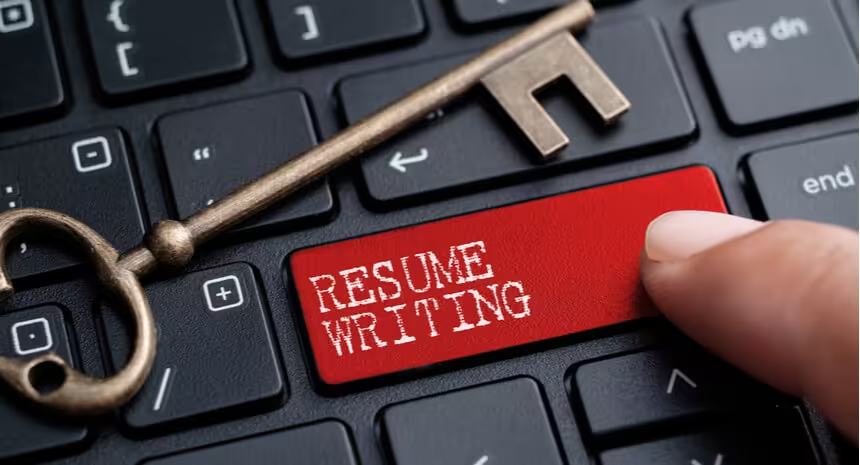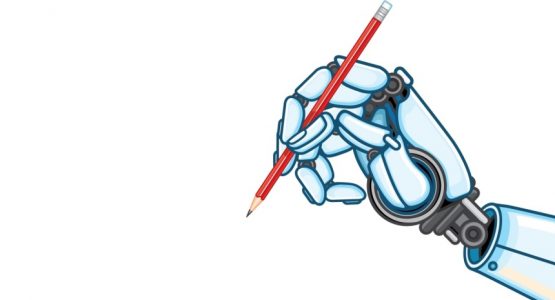Artificial intelligence (AI) is transforming how we write — from job postings to resumes and cover letters. Many job seekers use AI tools to craft application materials quickly, while employers increasingly rely on AI to write job descriptions and filter applicants.
But with AI-generated content becoming more common, how can you tell if something was written by AI?
This could make all the difference in your job search, but don't worry, we're here to help you sort through such questions.
In this guide, you will learn:
- How to identify AI-written resumes and cover letters to ensure your application stands out.
- How to recognize AI-generated job postings, which may lack clarity or even signal potential scams.
- How applicant tracking systems (ATS) use AI to scan and rank resumes.
- Different AI content detector tools and how they work.
Want to use AI to your advantage when writing your resume? Try our AI Resume Builder to craft a professional, ATS-friendly resume with personalized suggestions, easily customizable templates, and help along the way. In just a few clicks, you'll be ready to go!
How to Tell if a Resume or Cover Letter Was Written by AI
AI writing tools can help you write a resume or cover letter in seconds, but they often follow predictable patterns.
While AI-generated content can be useful, it may lack the personal touch that makes an application stand out.
Here's how to recognize an AI-written resume or cover letter and how to use AI wisely in your job search.
Patterns in resumes and cover letters written by AI
If you suspect AI created a resume or cover letter, look for these common characteristics:
- Overuse of generic, polished, but impersonal language. AI tends to produce text that is grammatically correct but overly formal and vague. Phrases like "I am a results-driven professional with a proven track record of success" are common in AI-generated content but lack specificity.
- Lack of personal anecdotes or unique phrasing. AI struggles to incorporate individual experiences meaningfully. If a resume summary or cover letter lacks personal storytelling or industry-specific language, it may have been AI-generated.
- Repetitive sentence structures or excessive bullet points. AI-generated resumes often rely on standard templates with similar sentence constructions, such as "Managed projects to increase efficiency" or "Implemented strategies to drive growth." The lack of variety can make the document feel robotic.
- Inclusion of skills and experiences that don't quite match the job description. AI tools sometimes pull in irrelevant or exaggerated skills, especially if a user provides minimal input. For example, a marketing resume might list advanced coding skills simply because AI recognizes them as valuable but doesn't verify their relevance.
How to check if a resume or cover letter was written by AI
If you're unsure whether a resume or cover letter was AI-generated, here are a few ways to check:
- Compare it to human-written examples. Look at well-crafted resumes and cover letters from real professionals. If a document feels too polished but lacks depth, it might be AI-generated.
- Look for missing personality or creative word choices. Human-written resumes often include customized details and industry-specific language. If the content feels generic and interchangeable, it may have been created by AI.
- Use AI content detector tools. Several online tools can analyze text and determine the likelihood that it was generated by AI (we'll cover these later). While these tools aren't always 100% accurate, they can provide a good starting point.
Should you use AI to write a resume or cover letter?
AI writing tools can be helpful, but relying solely on them can backfire. Here's a look at the pros and cons:
- Speeds up the writing process, helping job seekers quickly generate structured resumes and cover letters.
- Provide templates that organize your resume effectively.
- Helps with grammar, spelling, and formatting, ensuring a polished final product.
- Can provide inspiration and suggestions when you're unsure how to phrase something.
- Lacks personalization, making resumes and cover letters feel generic.
- May miss nuances that make a candidate unique, such as specific achievements or industry-specific language.
- May not be tailored to the job, making it less attractive to hiring managers.
- Runs the risk of being detected by hiring managers or AI content detectors, which could impact credibility.
Use AI as a starting point, but personalize your content. AI can help structure your resume and cover letter, but always tailor your application with specific details about your work experience, skills, and career goals. For example, when you use our Resume Builder, you can start with AI-generated suggestions and customize them to add your unique touch!
How to Tell if a Job Posting Was Written by AI
Just as job seekers use AI to write resumes and cover letters, many employers use AI to generate job postings. While this can save time, it often results in vague or overly polished job descriptions that lack crucial details.
In some cases, AI-generated job postings might even be red flags for low-quality or fraudulent job listings. Here's how to recognize an AI-written job posting and why it matters in your job search.
Signs that a job posting was written by AI
If a job posting seems off, look for these common characteristics of AI-written content:
- Excessive keywords, sometimes awkwardly placed. AI-generated job descriptions often overuse industry-related keywords, sometimes in unnatural ways. For example, a job post might repeatedly mention "SEO optimization, SEO strategy, SEO best practices" to appeal to search engines rather than human applicants.
- Vague or overly generic descriptions. AI-written job posts may lack specifics about responsibilities, required skills, or company values. Instead of clear expectations, you might see broad statements like "We seek a talented individual to drive business success."
- Repetitive phrases or entire sentences repeated with slight variations. AI often struggles with variety, leading to job postings that reuse similar wording throughout. For example, a description might say, "You will work with a dynamic team," followed by, "Our team is dynamic and fast-paced."
How to verify a job posting
If you suspect AI created a job posting or is potentially misleading, consider the following steps:
- Cross-check the company website. Legitimate companies should have a careers page with more details about their open roles. It could be a red flag if you can't find the listing there.
- Search for similar job postings. If the exact wording of a job description appears across multiple companies or job boards, it may have been AI-generated.
- Ask clarifying questions before applying. Contact the recruiter or hiring manager to request more details if the job description is vague. It might not be a genuine opportunity if they struggle to provide specific answers.
Understanding whether AI wrote a job posting can help you assess the legitimacy and quality of a job opportunity. AI-generated descriptions may leave out key details, such as day-to-day responsibilities, company culture, or growth opportunities.
Additionally, if a job post seems too generic, it might be mass-produced by AI and not tied to a legitimate position. Some scammers also use AI to create fake job listings that collect personal information.
AI-generated job postings aren't always bad, but knowing how to spot them can help avoid unclear roles or scams. Once you've identified a solid job opportunity, make sure what you put on your resume matches the description.

Does ATS Use AI?
Applicant tracking systems (ATS) are crucial to modern hiring. They help employers filter and rank job applications, and some ATS tools now use AI to streamline the process.
Let's break down what this means for job applications.
How AI-incorporated ATS works
ATS software is designed to help recruiters manage large volumes of applications efficiently. Many modern ATS tools incorporate AI to:
- Scan, sort, and rank resumes. AI-powered ATS systems analyze resumes to determine how well they match a job posting. The higher the match, the better the ranking.
- Detect keywords that match job descriptions. AI scans resumes for relevant industry terms, skills, and job-specific phrases. A resume missing key terms may be ranked lower, reducing its visibility to recruiters.
- Use AI-driven scoring to evaluate candidates. Some ATS tools assign scores to applications based on factors like experience, skills, and education, helping recruiters quickly identify top candidates.
Does ATS detect AI-generated resumes?
Most ATS tools don't specifically detect whether a resume was written by AI.
Instead, they focus on matching keywords, structure, and formatting. However, that doesn't mean AI-generated resumes will always pass through successfully. They must still be ATS-friendly and contain relevant information for the hiring manager.
Some ATS tools focus solely on keyword matching, meaning an AI-written resume may perform well if it includes relevant job-related terms.
However, if a resume lacks clear formatting, detailed work experience, or personalized achievements, it might not rank well in ATS or impress recruiters who review it manually.
Want to see if your resume will pass the ATS? Check out our ATS Resume Checker to see if yours is ATS-friendly.
AI Content Detector Tools: Can They Spot AI-Written Text?
With AI-generated writing becoming more common in resumes, cover letters, and job postings, AI content detector tools have emerged to help identify whether a human or an AI wrote text. But how do these tools work, and are they always accurate?
Popular AI content detectors
Several online tools analyze text and estimate the likelihood that it was written by AI. While these tools aren't perfect, they can provide insights into whether a resume, cover letter, or job posting was AI-generated.
Some of the most widely used AI detection tools include:
- GPTZero (gptzero.me): Designed specifically for educators and professionals, GPTZero detects AI-generated writing and highlights areas of concern.
- Writer.com AI Content Detector (writer.com): A free tool that scans text and provides an AI probability score.
- Copyleaks AI Detector (copyleaks.com): An advanced AI detection tool that supports multiple languages and identifies AI-written content in various formats.
- Sapling AI Detector (sapling.ai): Offers real-time AI detection for businesses and hiring professionals looking to verify content authenticity.
How AI content detectors work
AI content detection tools use machine learning models to analyze text and predict whether it was generated by AI. These tools generally:
- Analyze patterns and sentence structures. AI-generated text often follows predictable structures, lacks variation, and may include unnatural repetition.
- Compare text to known AI models. Detection tools check content against databases of outputs from AI models like ChatGPT, Bard, and Claude to identify similarities.
- Measure perplexity and burstiness. Perplexity measures how predictable the text is, while burstiness looks at sentence variation — AI text is often more uniform than human writing.
If you're using AI to assist with writing resumes or cover letters, these tools can give you an idea of how much your text resembles AI-generated content. However, hiring managers are unlikely to rely on AI detectors alone. Instead, they'll look for signs of personalization and authenticity.
Therefore, use AI as a writing assistant, but always refine your resume and cover letter with unique details, specific accomplishments, and industry-relevant language.
Key Takeaways
So, after asking yourself, "Was this written by AI?" you can now answer the question regarding resumes, cover letters, and other job-related materials.
-
AI-generated resumes lack personalization:
AI-written resumes and cover letters often use generic, polished language but may lack unique details. They tend to have repetitive sentence structures and include skills that don't always match the job description.
-
AI-written job postings may be vague:
AI-generated job descriptions can overuse keywords, rely on repetitive phrasing, and lack clear job expectations. If a posting feels too generic, cross-check the company website, search for similar listings, and ask clarifying questions before applying.
-
ATS uses AI to scan and rank resumes:
Applicant tracking systems (ATS) don't necessarily detect AI-written resumes but prioritize keyword matching and structure. A poorly formatted or too generic resume may not rank well.
-
AI content detectors can identify AI-written text:
Tools like GPTZero, Copyleaks, and Sapling AI Detector analyze sentence structure and word patterns to estimate whether the text was AI-generated.
-
Bottom line:
AI can be a helpful tool, but human input remains essential. Whether you're writing a resume, applying for jobs, or evaluating job postings, adding a personal touch will always make a difference.
Further AI Resources for Your Job Search
Along with our Resume Builder and ATS Checker, Resume-Now provides additional AI tools you can use to help get your next job.
- Cover Letter Builder: Just like our Resume Builder, this generator creates a cover letter tailored to your needs and allows you to customize it to your liking. It even offers cover letter templates that you can match with your resume to incorporate consistency.
- Resume Summary Generator: Your resume should begin with a profile that summarizes your best and most relevant qualifications. Not sure what to say? Let us assemble one that will stand out with applicant tracking systems and hiring managers!
With these resources, you can save valuable time and energy as you search for a job. Try them out today and see how to enhance your next job application!
Conor is a writer for Resume Now. He has over five years of professional writing experience and professional development training. Conor has written on a range of career development topics.
More resources

How to Write a Resume: Guide & Examples for 2025
If you re wondering how to write a resume that grabs attenti...

Should You Put Your Address on Your Resume? (Guide + 5 Example Resume Headers)
Should you put your address on your resume? We ll answer you...

Carpenter Resume: Examples, Templates & Tips for 2025
Conor McMahon CPRWCareer Advice Expert Conor is a writer for ...

Student Resume: 2025 Examples & Templates
Check out our guide for help writing a job-winning student res...

Sales Planner Resume: Examples, Templates & Tips for 2025
Whether you re an experienced professional or just starting ...

